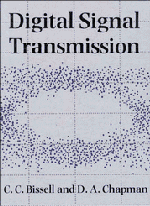Book contents
- Frontmatter
- Contents
- Preface
- 1 Introduction
- PART 1 MODELS
- PART 2 PROCESSES
- PART 3 DIGITAL TRANSMISSION OVER THE PUBLIC SWITCHED TELEPHONE NETWORK
- 7 Analogue and digital sources
- 8 Digital transmission hierarchies
- 9 An optical fibre link
- Appendix A Fourier series and transforms
- Appendix B Convolution
- Appendix C Modelling applications of spreadsheets
- Answers to numerical exercises
- References
- Index
7 - Analogue and digital sources
from PART 3 - DIGITAL TRANSMISSION OVER THE PUBLIC SWITCHED TELEPHONE NETWORK
Published online by Cambridge University Press: 05 June 2012
- Frontmatter
- Contents
- Preface
- 1 Introduction
- PART 1 MODELS
- PART 2 PROCESSES
- PART 3 DIGITAL TRANSMISSION OVER THE PUBLIC SWITCHED TELEPHONE NETWORK
- 7 Analogue and digital sources
- 8 Digital transmission hierarchies
- 9 An optical fibre link
- Appendix A Fourier series and transforms
- Appendix B Convolution
- Appendix C Modelling applications of spreadsheets
- Answers to numerical exercises
- References
- Index
Summary
Introduction
This chapter is concerned with the initial processing of analogue and digital signal sources prior to transmission over a public switched telephone network (PSTN). A major topic is pulse code modulation (PCM), a technique for encoding analogue signals and transmitting them over a digital link. (The name was originally chosen by analogy with other pulse modulation techniques such as pulse amplitude modulation (PAM) and pulse width modulation (PWM).) PCM involves sampling the analogue waveform at an appropriate rate, encoding the samples in digital (normally binary) form, and then transmitting the coded samples using a suitable digital waveform (which is also often binary but may well be ternary, quaternary or other). At the receiver the digital waveform is decoded, and the original message signal is reconstructed from the sample values. The complete process is illustrated in Fig. 7.1, where the transmitted digital signal has been shown as a baseband binary waveform for simplicity.
The most common application of PCM is perhaps in telephony, although the analogue message signal can originate from a wide range of sources other than a telephone handset: telemetry, radio, video, and so on. Similar techniques are also used for digital audio recording.
Later sections of the chapter introduce alternatives to standard PCM for the digital transmission of analogue signals, and also discuss the need for modems when using digital sources such as facsimile or computer terminals. Finally, some aspects of interfacing to an integrated services digital network ISDN) are introduced.
- Type
- Chapter
- Information
- Digital Signal Transmission , pp. 236 - 262Publisher: Cambridge University PressPrint publication year: 1992



